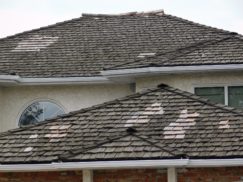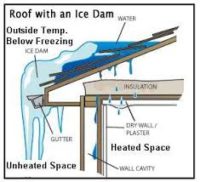This time of year we are all thankful for the roof over our heads. To ensure that it keeps us protected from the elements you will need to monitor it throughout the year. Your roof is not waterproof but is water resistant which means that at some point you may experience a leak.
Our harsh climate puts our roofs to the test and although there are different types of roofs there are common things to watch for. You will want to watch for debris that can clog gutters and valleys, loose flashing and any damage to the roof coverings. While it is important to check your roof this can be dangerous. You can use binoculars for a quick visual but you may want to consider calling a professional after a bad storm to ensure that there hasn’t been any damage that needs to be repaired. Home inspectors are equipped with infrared thermal cameras and moisture meters which can be used to find and test the roof structure. Ensure you use an inspector who is trained in thermal technology.
There are two roof categories: pitched roof and a low-sloped roof. There are four common roof-covering materials used on a pitched roof and each should be monitored differently.

- Asphalt shingles
- Service life of 15 to 40 years depending on quality of materials, installation, direct sun exposure and maintenance.
- Shingles will start to curl and the granular covering will start to wear away when they are at or near end of life
- Wood shingles and shakes
- Service life of 20 to 30 years depending on the type and thickness of wood and slope of roof. Climate also effects the longevity of the product. Hot and humid climates would expect a shorter service life.
- Shingles and shakes will start to dry out, crack and curl when they are nearing the end of their life and in a humid climate they will start to rot. When more than one third of the shingles are showing these sign you will want to consider replacing your roof.
- Shingles can be treated with a preservative but you will want to avoid walking on them to prevent breakage.
- Metal roofing
- One of the longest lasting roof coverings with a service life of 50 years or more if properly painted and maintained.
- Monitor for corrosion, rusting, pitting or leaking seams.
- Slate, clay tile and asbestos cement shingles
- This is the longest lasting roof covering if properly maintained and if it was made with high quality materials. This covering could last the life of the structure.
- Due to the brittle materials used in these shingles they should not be walked on.
- Look for broken or slipping shingles as well as moss growth.
No roof should be flat; all roofs must have at least a slight slope to allow for proper drainage. Roofs that appear flat are called low-slope roofs. This style of roof can be expensive to repair so it is important that they are properly maintained. If you see water pooling on your roof that is a sign that you need to call a professional to look at your roof. This is either because of improper drainage or sagging which needs to be structurally repaired. Like pitched roofs there are different covering materials used on low-slope roofs. They are:
- Roll roofing
- It is important to have the roof looked at before and after winter.
- Inspect for blistering, cracking, tears and seams should be checked for lifting or separation.
- Built-up roofing (BUR)
- As the name implies this type of roof is composed of several layers of roofing and topped with a thin layer of crushed stone or gravel.
- Service life can vary greatly but usually last 20 years depending on quality, number of plies, climate and drainage.
- Moisture can build up between the layers and damage the roof so regular maintenance and regular inspections are important. Look for blistering, pooling and wrinkles.
- Single-ply membrane roofing
- As the name implies this type of roof consists of a single ply and also includes a protective covering to protect from UV rays.
- Properly installed roofs should last 20 years.
- Seams need to be carefully monitored and the UV ray protective cover will need to be reapplied throughout the life of the roof. Check for water ponding, poor drainage, fading of the protective coating and surface degradation.
Ice Dams

With our cold climate ice damming can be a common problem to watch for. Heat loss through the roof and heat from the sun cause snow on the roof to melt and run down onto the overhang. The water then freezes above the gutter causing an ice dam, trapping water from melting snow and forces it under the shingles and into the building.
Now you should know what’s required to maintain your roof and get the longest possible life out of it. Remember to always be safe and view your roof from the ground and hire a professional for a more thorough inspection.
The post Taking Care of Your Roof appeared first on Edmonton Home Inspector | Admirable Inspection Services.
Comments
Post a Comment